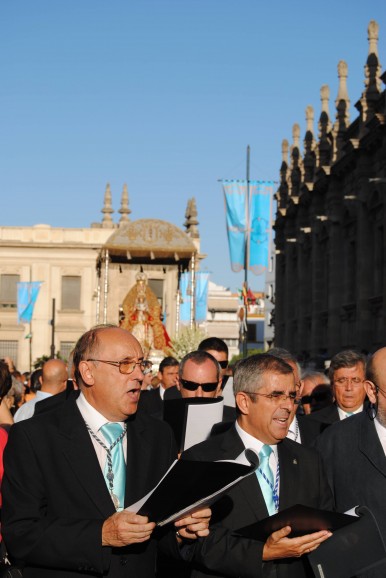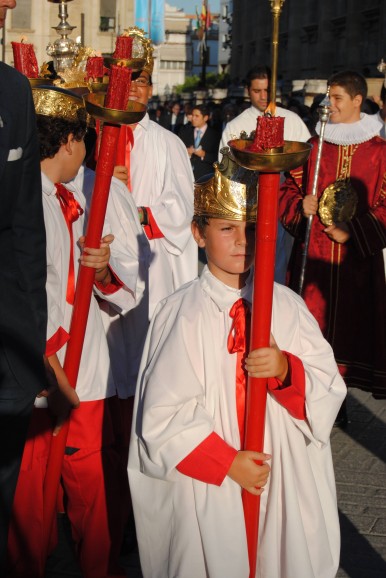
POST BY AUGUST’S SPECIAL GUEST BLOGGER: KIM CAUSIE
Monday 15 August: today I felt a tad more like a native Sevillana. Although it was the last day of the puente (long weekend), I didn’t enjoy a well-deserved lie-in before going back to the grind. Instead, along with hundreds of Sevillanos, I was up before the sun and on my way into the city centre, all of us heading to the same place: to see our city’s Patron and celebrate El Día de la Asunción (Day of the Assumption).
Walking from the bus stop in the Prado, there seemed to be something special about this paso, something that made it stand out from others: unlike Semana Santa, when people are frantically darting from one point of the city to another to spot their favourite Cristo or Virgen, this one was all about her: La Virgen de los Reyes (the Kings’ Virgin), the patron of Seville. The scene reminded me somewhat of Lowry’s The Football Match, albeit a lot brighter and the result of a different type of passion. Entire families, elderly couples, and groups of teenagers were all on their way to find a spot to watch her pass, some even setting out seats to rest weary feet during the wait.

The light also gave it a different perspective too – I had only seen pasos when the sun was either at its most intense or under the street lamps during the night-time Semana Santa processions. Looking up to see the Giralda illuminated by the first morning rays, and witnessing the shadows that blanketed the cathedral and the Giraldillo being gradually lifted away, was spectacular.
The Virgin left the Puerta de los Palos at 8 o’clock to the sound of the Giralda’s 24 bells – a powerful chiming that echoed through the streets and could no doubt be heard throughout the city. In comparison to most Semana Santa pasos, this one is relatively short, only making a loop of the cathedral (turning left down Alemanes, then Avenida de la Constitución, to Fray Ceferino González, Plaza del Triunfo, Plaza Virgen de los Reyes, and finishing once more at Puerta de los Palos) and only lasting around an hour.

The cortege was led by the Municipal band and the cute niños carráncanos (choirboys) and followed by members of the Asociación de Fieles Nuestra Señora de los Reyes y San Fernando (Association of those Faithful to the Kings’ Virgin and Saint Fernando). They supported themselves with long candles and dressed in dark attire, necks adorned with their blue and white pendants. At each of the cathedral’s corners, the church choir sang homage to the Virgen and the bells chimed once more.

Before the Virgin came the simpecado (the Hermandad or Association’s emblem), which always precedes her in any procession, especially that of the pilgrimage to El Rocío. This one was clearly of age and intricately woven with gold thread that twinkled in the warm dawn light. And then we saw her slowly appear in the distance, and the crowd quietened down and watched agog. “¡Qué bien! ¡Ya viene!,” exclaimed a little one at my side, happy to see that the Virgen was making her way towards us.
Unbeknownst to me, I had positioned myself ideally, in front of the Giraldillo - one of the points where the choir burst into song, and the costaleros rested the paso onto the ground, their white-clad legs poking out from underneath. And there she was peering over us: many of the people around me crossed themselves and kissed their hands. She was dressed in full regalia, plush red, with golden thread work, holding the babe in her hands.

And then, one of my favourite moments, la levantada, when the capataz hits the tocador three times, signalling to the costaleros that they must lift the paso and start their march once more. Up it went, in one almighty swoop, and onward with such agility – it is almost too easy to forget that it is carried by men.
Lastly, the procession was closed by goose-stepping military men and women, whom the crowds applauded fervently. They had stern faces, holding weapons in place on their left shoulders, and were already clearly feeling the heat as the sun’s strength rapidly increased. And then, after an hour, even before the last soldier had passed, the crowd dispersed toward the cafeterias – the procession itself was over.

I have been open about my faith on my own blog (see below), or maybe lack of, but these are moments that touch my heart and give me a sense of warmth. Where else, especially on a Bank Holiday, would so many people make the effort to get up at 7am to share such an event? In Andalucia, it is the norm. A man next to me told me that he takes his daughter to see the procession every year. It is his family’s custom, and thanks to many people like him, it remains so - a custom, a tradition, and I hope that it won’t die out in our lifetime.
Kim Causier lives in Seville, where she is currently working as an in-house translator. Like many expats, she has a passion for Andalusia's language, food, and culture, and enjoys writing about her experiences on her blog, Becoming Sevillana.